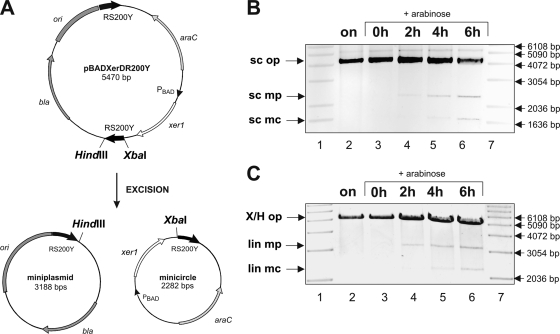FIG. 3.
Xer1 mediates excisions between two 200-bp RS. (A) Schematic representation of excision of plasmid pBADXerDR200Y, carrying two 200-bp direct repeat RS (RS200Y; indicated by bold black arrows) along with the xer1 gene (white arrow). Induction of xer1 results in excision of the DNA fragment flanked by the two direct repeat RS200Y elements, resulting in two recombination products: a miniplasmid (mp) and a minicircle (mc). ori, pBR322 origin; bla, ampicillin resistance gene; araC, regulatory gene of l-arabinose operon. (B) Inverted image of agarose gel electrophoresis of supercoiled (sc) recombination products. The supercoiled miniplasmid (sc mp) and supercoiled minicircle (sc mc) were visible 2 h (lane 4), 4 h (lane 5), and 6 h (lane 6) after xer1 induction, in addition to the band corresponding to the unrecombined original plasmid (sc op). Recombination products were not visible for the uninduced cells grown overnight (on; lane 2) and the sample taken at the start of induction (0 h; lane 3). Lanes 1 and 7, molecular size marker (1-kb ladder; Invitrogen). (C) Inverted image of agarose gel electrophoresis of HindIII- and XbaI-linearized (lin) recombination products, confirming the sizes of the original unrecombined plasmid pBADXerDR200Y (X/H op; 5.5 kb) and the minicircle and miniplasmid (lin mc [2.3 kb] and lin mp [3.2 kb]) excised out of it upon xer1 induction. Lanes 1 and 7, molecular size marker (1-kb ladder; Invitrogen).

